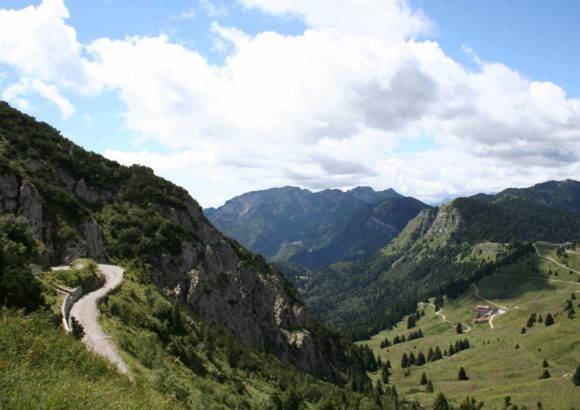Room 5
The great
transformation
From the end of the 18th century, it was an event that brought great change both to the economic and social environment and the landscape of Garda: the music together with its antique clothes and furniture, will take the visitors back in time as if they were in an elegant hotel of the Belle Époque.
The Grand tour of the Garda.
Italy, and in particular Venice, Rome and Naples, were very popular destinations of the Grand tour. Also Garda was visited by Albrecht Dürer in 1495 and in 1580 by Montaigne who had just been in Rovereto, the same as Goethe would do in 1786. His enthusiasm before the “majestic natural spectacle that Lake Garda is” captured the imagination of the German people stimulating their interest in the area which would eventually lead to the advent of tourism.
The papermaking industry.
In 1875, the Maffizzolis, a family of entrepreneurs from Toscolano, introduced an important innovation: the “continuous machine”. Paper mills shaped the scenery of the valley giving it that industrial appearance that can be seen in the photographs of the first years of the 1900s. However, the large plant built by the Maffizzolis on the shore of the lake in Toscolano in 1905 laid the basis for the industrial decline of the Valley which would cease altogether in the post-war era. The historical and environmental value of the Valley appears evident to anyone who, visiting it, sees the remains of old factories surrounded by lush greenery mixed to the ruins. For additional information on this subject, you can visit the Museum of Paper of Toscolano Maderno.
Campione: an industrial town.
In those years, there was a new industrial town in the northern side of the lake, besides Gargnano. At the end of the 19th century, Giacomo Feltrinelli, an entrepreneur from Gargnano, founded a large cotton mill in the peninsula of Campione. At the same time, new houses for the employees were built under the direction of Vittorio Olcese. Like in most Italian and European towns inhabited by workers, in Campione the needs of production, in particular the stability of the labour force, coexisted with the possibility of integrating a working class with mainly rural origins into a new type of community. A video shows the appearance of the industrial town before the modernisation of the peninsula, very popular today among the many tourists who practise water sports such as windsurfing, kitesurfing and sailing.
The origin of the Hospitality Industry.
In the 1870s, the Northern part of Garda in Trentino, a region which was considered at that time the “southern province of the Austro-Hungarian empire”, gained new notoriety. The proud determination of the inhabitants to preserve their past inspired the construction of new accommodations in the nearby Riva. This part of Garda and the town became increasingly popular among Mitteleuropean tourists and a holiday destination for writers such as Kafka and the brothers Mann.
The Wellness Town of Gardone Riviera.
“A small village of little importance, no value if you take away the lemons”: that’s how a guidebook described Gardone in 1878. Only ten years later, instead, the same town was described as a “charming town for a pleasant stay in the colder months”. Starting from the 1880s, following the example of wellness centres in the part of Garda in Trentino, Gardone became a holiday destination for a growing number of German tourists who would arrive in September and overwinter on the lake. Illuminated by electric light since the first years of its construction, the Grand Hotel is an imposing building with 300 rooms all overlooking the lake, dining halls and conversation rooms, reading areas, music and game rooms, glass galleries and a tropical garden.



















